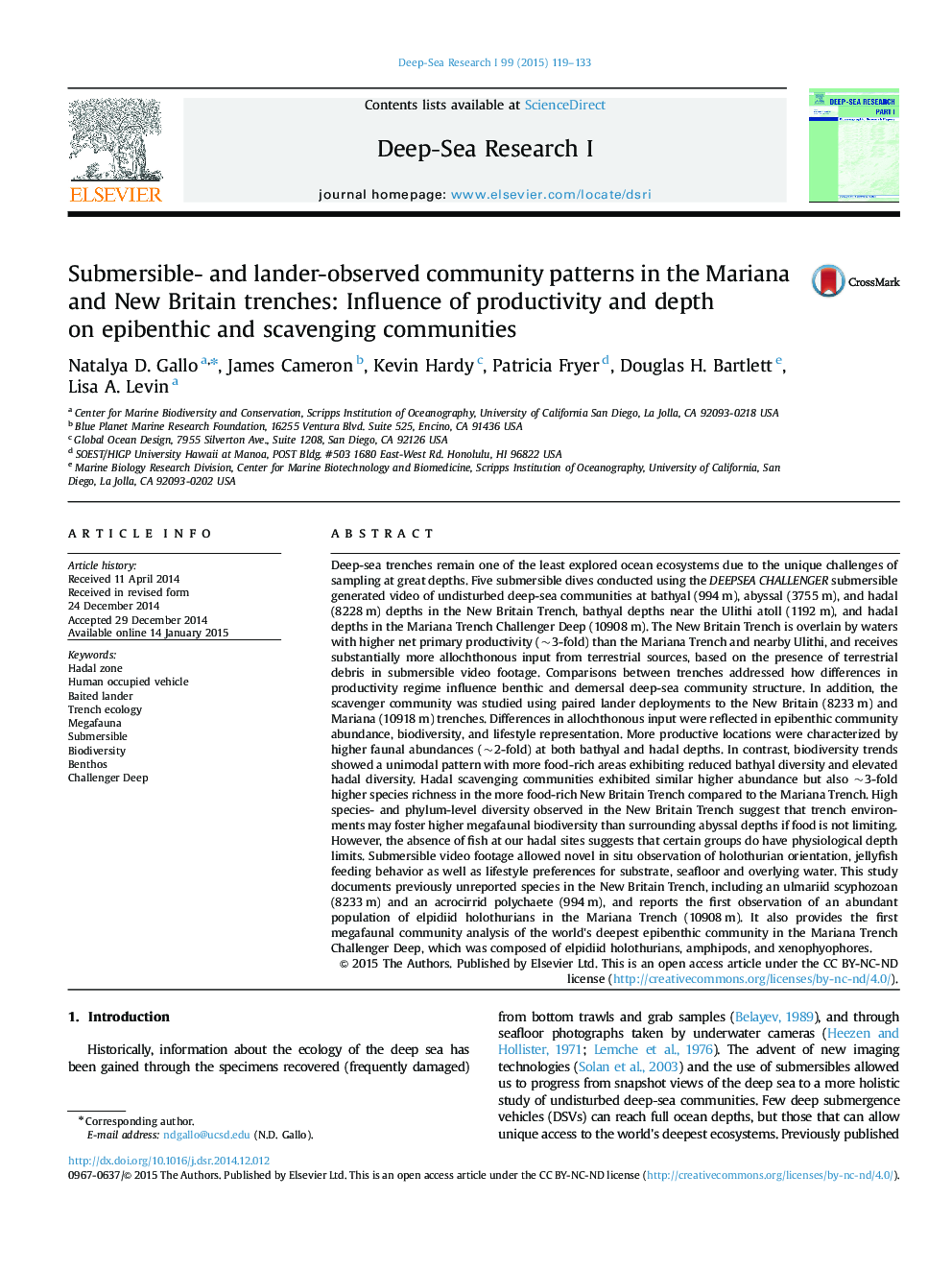| کد مقاله | کد نشریه | سال انتشار | مقاله انگلیسی | نسخه تمام متن |
|---|---|---|---|---|
| 6383547 | 1626331 | 2015 | 15 صفحه PDF | دانلود رایگان |
عنوان انگلیسی مقاله ISI
Submersible- and lander-observed community patterns in the Mariana and New Britain trenches: Influence of productivity and depth on epibenthic and scavenging communities
ترجمه فارسی عنوان
الگوهای اجتماعی زیرزمینی و فرود در مرزهای مرینا و نیو بریتانیا: تأثیر بهره وری و عمق در جوامع اپی بنتونیک و فاضلاب
دانلود مقاله + سفارش ترجمه
دانلود مقاله ISI انگلیسی
رایگان برای ایرانیان
کلمات کلیدی
موضوعات مرتبط
مهندسی و علوم پایه
علوم زمین و سیارات
زمین شناسی
چکیده انگلیسی
Deep-sea trenches remain one of the least explored ocean ecosystems due to the unique challenges of sampling at great depths. Five submersible dives conducted using the DEEPSEA CHALLENGER submersible generated video of undisturbed deep-sea communities at bathyal (994 m), abyssal (3755 m), and hadal (8228 m) depths in the New Britain Trench, bathyal depths near the Ulithi atoll (1192 m), and hadal depths in the Mariana Trench Challenger Deep (10908 m). The New Britain Trench is overlain by waters with higher net primary productivity (~3-fold) than the Mariana Trench and nearby Ulithi, and receives substantially more allochthonous input from terrestrial sources, based on the presence of terrestrial debris in submersible video footage. Comparisons between trenches addressed how differences in productivity regime influence benthic and demersal deep-sea community structure. In addition, the scavenger community was studied using paired lander deployments to the New Britain (8233 m) and Mariana (10918 m) trenches. Differences in allochthonous input were reflected in epibenthic community abundance, biodiversity, and lifestyle representation. More productive locations were characterized by higher faunal abundances (~2-fold) at both bathyal and hadal depths. In contrast, biodiversity trends showed a unimodal pattern with more food-rich areas exhibiting reduced bathyal diversity and elevated hadal diversity. Hadal scavenging communities exhibited similar higher abundance but also ~3-fold higher species richness in the more food-rich New Britain Trench compared to the Mariana Trench. High species- and phylum-level diversity observed in the New Britain Trench suggest that trench environments may foster higher megafaunal biodiversity than surrounding abyssal depths if food is not limiting. However, the absence of fish at our hadal sites suggests that certain groups do have physiological depth limits. Submersible video footage allowed novel in situ observation of holothurian orientation, jellyfish feeding behavior as well as lifestyle preferences for substrate, seafloor and overlying water. This study documents previously unreported species in the New Britain Trench, including an ulmariid scyphozoan (8233 m) and an acrocirrid polychaete (994 m), and reports the first observation of an abundant population of elpidiid holothurians in the Mariana Trench (10908 m). It also provides the first megafaunal community analysis of the world׳s deepest epibenthic community in the Mariana Trench Challenger Deep, which was composed of elpidiid holothurians, amphipods, and xenophyophores.
ناشر
Database: Elsevier - ScienceDirect (ساینس دایرکت)
Journal: Deep Sea Research Part I: Oceanographic Research Papers - Volume 99, May 2015, Pages 119-133
Journal: Deep Sea Research Part I: Oceanographic Research Papers - Volume 99, May 2015, Pages 119-133
نویسندگان
Natalya D. Gallo, James Cameron James Cameron, Kevin Hardy Kevin Hardy, Patricia Fryer Patricia Fryer, Douglas H. Bartlett Douglas H. Bartlett, Lisa A. Levin Lisa A. Levin,
